Our Comprehensive Guide to Writing a Statement of Work
Last Updated on August 1, 2021 by Owen McGab Enaohwo
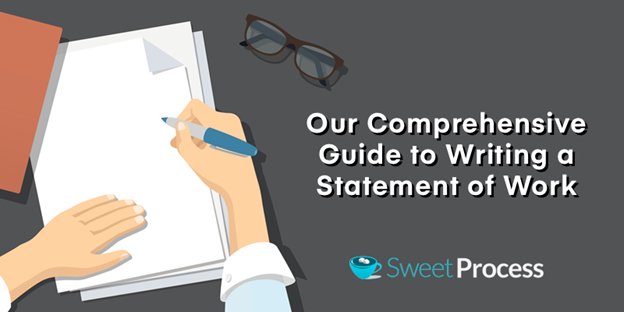
This guide will help you understand what a statement of work (SoW) is and show you how to create a complete SoW for your industry.
First, you’ll learn what a statement of work is and what it isn’t. Then we’ll show you why and when you need a statement of work, the different statements of work categories, the best practices for writing your statement of work, and everything else you need to know to create the perfect SoW.
We’ll also guide you through the process of creating an SoW for your next project using a simple statement of work template.
Sound good? Let’s dive right in.
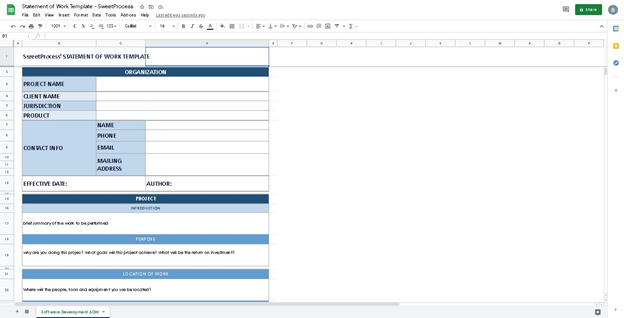
Statement of Work – Content Index
Chapter 1: What is a Statement of Work?
Chapter 2: What Makes up a Statement of Work?
Chapter 3: Who Creates a Statement of Work?
Chapter 4: Benefits of Having an SoW
Chapter 5: When Should You Write a Statement of Work?
Chapter 6: Three Types/Categories of Statement of Work
Chapter 7: How to Write a Statement of Work for Your Industry
Chapter 8: Common Mistakes People Make When Creating a Statement of Work
Chapter 9: Best Practices for Creating a Statement of Work
What is a Statement of Work?

Statement of Work, SOW, or SoW definition
A statement of work, SOW, or SoW is a document that defines the terms of agreement for a project between a client and a service provider (an agency, contractor, etc.). It captures all aspects of what’s included in your project and what’s not, i.e., deliverables, project timeline, payment schedule, project objectives, tasks, milestones, etc.
Because the SoW is a critical document that lays the foundation for your project, it is important not to mistake it for other important project management (PM) documents.
In the following section, we will highlight the differences between the SoW and these three PM documents:
- Scope of work
- Master service agreement
- Project charter
Scope of Work vs. SoW
The scope of work is a section of the SoW that describes the project outcomes, objectives, and milestones, and highlights the activities and tasks to be done to achieve them.
The SoW is a more comprehensive document than the scope of work because it offers much more information. It highlights the project’s goals, guidelines, deliverables, schedule, costs, and more.
Having a detailed scope of work helps you avoid unforeseen growth and changes to the project scope.
Master Service Agreement (MSA) vs. SoW
The MSA is a document that defines the terms of the agreement between a client and a service provider (agency, contractor, etc.) for present and future projects and transactions. The SoW deals with the specifics of a single project.
The purpose of an MSA is for both parties to agree on some foundational terms at the beginning of their relationship. This way, future transactions can be agreed upon more quickly.
The MSA serves as a guide when creating the SoW. Some of the key points highlighted in the MSA are: payment terms, general services, confidentiality, audits, terms and termination, warranties, support or deployment terms, etc.
Project Charter vs. Statement of Work
The project charter is a more big-picture document that covers the project objectives and expected outcomes of the different phases of your project. Unlike the SoW, it does not address each task, deliverable, or milestone in detail.
Project charters are used at the beginning of the project after the SoW has been signed off on. They are used for larger projects with different phases.
What Makes up a Statement of Work?
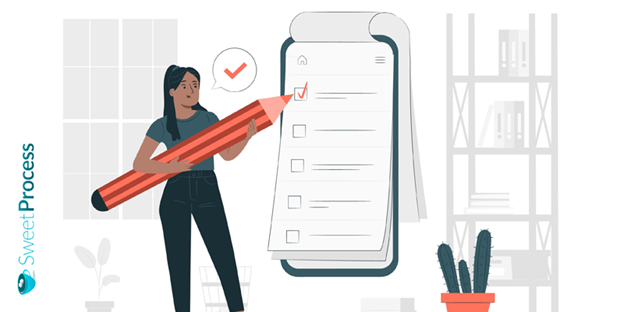
Intro/Overview
This is the first segment of your SoW. Your intro should summarize the work to be performed, the purpose of your project, who will be involved in this project, and what this project will achieve.
Purpose
This segment explains why you’re doing this project. What goals will your project achieve? And what will be the return on investment?
Scope of work
The scope of work segment explains all the work to be done: the approach to be taken, the necessary steps, the different phases of the project, and the hardware and software involved.
Tasks
Break down the steps outlined in your scope of work segment into detailed tasks. Be very specific with these tasks, and don’t leave anything out.
Location of work
Where will the people, tools, and equipment used be located? Is your project site-specific?
Government approval
Will you need to get the approval of a governing body to implement any phase of this project? If yes, provide every relevant detail in this section.
Period of performance/Milestones
This segment should contain the estimated start and finish time for the project and a breakdown of the time required to accomplish each milestone.
Deliverables schedule
List out the deliverables for each phase of your project and when they are due.
Applicable standards
Include any industry-specific standards to be adhered to.
Acceptance criteria
This segment specifies how the client will determine if the project has been implemented successfully.
Payment schedule
How much will it cost to implement this project? Include the budget for this project in this segment and your proposed payment plan/schedule, i.e., upfront payment, overtime, phase-by-phase payment, or full payment after completion.
Signoff and conclusion
This segment allows you to address any part of the project that does not fit into the above categories: how the deliverables will be accepted, who is in charge of reviewing and signing off on the deliverables, post-project support, security measures or restrictions, etc.
Download our FREE Statement of Work Template!
Who Creates a Statement of Work?

The answer to this question depends on the type of project and its complexity. In some cases, the SoW will be provided by the client, and in others, the service provider, contractor, or agency will be responsible for creating the SoW.
The number of people involved in creating an SoW depends on the complexity of the project. Ideally, these are the five roles involved in creating a statement of work for any project:
1. Coordinator
This is the person in charge of planning and creating the general template of the SoW document, sending the copy to relevant internal parties for their input, and getting sign-offs.
2. Author
This person is in charge of writing the SoW draft. Depending on how complex the project is, an SoW document can have more than one author. Different departments (e.g., marketing, finance, engineering, etc.) can have an author assigned to your SoW.
3. Reviewer
This person reviews your SoW draft and makes relevant comments and suggestions for the editor. Depending on the complexity of the project, there can be more than one reviewer.
4. Editor
The editor takes the feedback from the reviewer and works and makes the necessary corrections and changes in the SoW document.
5. Approver
This person does the final approval and signs off on the SoW. This person approves and signs the SOW document.
Similar read: Workflow Management Software: What It Is and Why You Need It
Collaborate with your team to create, implement, and update your SoW using SweetProcess
Universities, banks, hospitals, software companies, and first responder government organizations use SweetProcess to document repetitive processes and procedures, assign deliverables, collaborate with team members on tasks, and deliver consistent results to clients regardless of the size of their organization.
SweetProcess is a tool that allows you to effectively collaborate with your team on tasks (such as creating a statement of work), document processes and procedures required to deliver a project and ensure consistency in project implementation.
Here are two examples of organizations that use SweetProcess to simplify workflow and ensure company-wide efficiency and consistency.
How Forensic Analytical Consulting Services Inc. Is Enhancing Growth and Employee Efficiency With SweetProcess
Forensic Analytical Consulting Services (FACS) is an environmental health consulting firm that offers environmental health consulting services and industrial services in the United States.
As FACS began to expand to multiple locations, maintaining consistency across the organization became a challenge.
Although FACS already had existing standard operating procedures (SOP), the SOPs fell short of streamlining their workflow. Employees would rather not use them due to their complexity. It became apparent to Kevin Trapp, the director of operations at FACS, that they needed a better system.
Kevin decided it was time to go a different route. Part of his goal was to link to specific SOPs instead of having team members read an entire document to find specific tasks.
How SweetProcess Changed the Game at FACS
Adopting SweetProcess in the organization was a collective effort. All hands were on deck to make it work, and they hoped to get the most out of it. Was it all worth it in the end? From what Kevin says in his interview with us, it was.
Here are the specific areas where the entire organization has benefited from using SweetProcess:
1. Effective business process documentation
The team at FACS recognized the need for documenting SOPs long before discovering SweetProcess and started to do it with PDF files, but the SOPs were not living up to expectations. They did their best with creating the documentation, but their options were limited due to the tool they were using.
It is a different story with SweetProcess. They are now able to document SOPs that are comprehensive. Team members can find the specific information they need without looking through the entire document.
2. Seamless employee onboarding and training
The organization has grown in recent years, leading to the hiring of new employees. Onboarding a high number of new employees manually was demanding, requiring so much time and resources.
The training process was unending as the employees continued to ask questions on how to get things done. Established employees who were unclear about certain tasks would also ask questions, and Kevin was on the receiving end of all the questions.
He was relieved when they adopted SweetProcess because it lifted the employee onboarding and training weight off his shoulders.
New and established employees are now more confident in executing their duties because they can get the help they need independently without constantly asking someone else.
3. Accessible central knowledge base
Employees can give their best when equipped with the tools they need, including making work-related information available and accessible.
Having a central knowledge base where everyone can access all information is the biggest testament of using SweetProcess for Kevin.
Listen to our interview with Kevin Trapp and learn more about how Forensic Analytical Consulting Services built a more efficient workforce by documenting its business processes effectively with SweetProcess.
How Americanflat is Enhancing Overall Business Operations With SweetProcess
Americanflat is an interior decoration company that offers stylish and exclusive designs to households. This company collaborates with over 150 artists from different parts of the world to create original designs at affordable prices.
The president of Americanflat, Giorgio Piccoli, understood that streamlining his business operations was key to running a successful business and started documenting his business processes early on with a workflow system.
But as his business began to expand, the need for a more effective system arose. He found SweetProcess, and his expansion became seamless.
In his interview with us, Giorgio tells us how SweetProcess has enhanced his overall business operations.
How SweetProcess Upped the Game at Americanflat
Giorgio’s mission to provide high-quality interior decoration designs at affordable rates was enhanced by using the right system in his operations. Here are four ways that SweetProcess contributed to the organization’s success:
1. High-level security
The team at Americanflat was using a workflow tool before SweetProcess, but security was a significant concern. The security of their documents was in having them in different places. Giorgio felt more at ease having all his documents in one location with authorized access on SweetProcess.
2. Seamless employee onboarding
Like many organizations, Giorgio and his team were faced with the tedious task of training each new employee to the organization personally, but all that has changed now. Employee onboarding has never been easier at Americanflat, thanks to SweetProcess.
3. Effective documentation
SweetProcess offers various features for documentation, including texts, videos, charts, etc. Americanflat has transitioned from writing long, boring essays in the name of documentation to creating short videos that get the job done.
4. Decentralized knowledge base
The absence of employees who are privy to tribal knowledge used to stall the workflow and cause setbacks. Giorgio explains that being able to keep their workflow moving in the absence of certain employees is a game-changer.
“It’s just more about sharing information amongst the different people in the team. If someone is not available, for example, there’s a place where we can go.”
Speaking further, Giorgio explains that SweetProcess makes work flexible for his employees. This is remarkable as his team members work remotely.
Whether your team operates remotely or onsite, you can empower them with the right resources to do their job more efficiently. Sign up for a 14-day free trial of SweetProcess to enjoy the benefits of streamlining your business operations. No initial commitment is required—not even a credit card!
SweetProcess also allows you to:
- Document procedures and repetitive tasks.
- Create, share, and ensure the correct adoption of your business’s policies.
- Craft, collaborate and refine processes so that your organization can continue to grow and improve.
- Manage tasks, track all the latest activities, or look back in the history of any task or procedure.
- Turn your existing procedures and policies into a knowledge base for your employees or clients.
You can learn more about SweetProcess or claim your 14-day free trial without any initial commitment—not even a credit card!
Benefits of Having an SoW
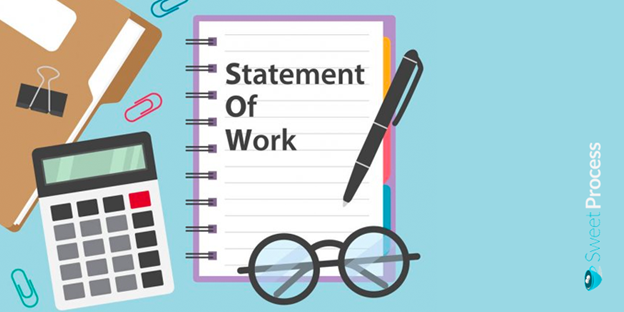
1. It saves you time
A thorough SoW will help all parties involved understand their roles and responsibilities, as well as the resources needed to execute the project. This will save you a lot of time that would have been spent on back-and-forth email chains because the relevant parties will have fewer questions.
2. It’s detailed and helps you avoid assumptions
An SoW document gives you enough room to describe precisely what’s included in a project and what’s not.
3. It positions you as a professional
As a service provider (agency, contractor, etc.), presenting a thorough statement of work to a client can help position you as a professional and be the starting point of a long-term business relationship.
4. It helps you make more precise estimates
While creating your SoW, you’ll be able to adjust your figures, make more precise estimates for your budget and project timeline, and remember any relevant information that could have been left out in other documents.
5. It keeps processes organized
A detailed project SoW keeps your internal and external workflows organized. Team members, service providers, and clients can refer to the document and know what to do and when to do it. Your operations will run smoothly even when you’re not available.
When Should You Write a Statement of Work?
We advise that you create your statement of work document:
- After your client has decided what they want. Creating an SoW can be very tasking. Making one prematurely can result in a tedious back-and-forth process should your clients change their minds on the project outcomes.
- Before your project kicks off, creating an SoW requires a lot of time. You don’t want to hold up the project planning and implementation process after your client has approved your estimates.
Similar read: The Ultimate Business Process Consultant Guide Every Business Needs
Three Types of Statement of Work

1. Design/detail statement of work
This category of SoW gives the service provider (contractor, agency, etc.) or supplier the exact requirements needed to complete a project. It provides clear instructions on how to do the work and what processes to follow.
Type of materials to be used, measurements, quality control requirements, etc., are provided in a design/detail SoW. This is the preferred type of SoW for manufacturing or construction projects.
Because the service provider is obligated to follow specific requirements provided by the client, the client assumes most of the risk. In this type of SOW, the buyer, client, or entity assumes most of the risks since the contractor is obligated to follow the standards laid out for them.
2. Level of effort/time and materials/unit rate statement of work
This SoW category is more flexible than a design/detail SoW. It breaks down the different tasks and deliverables based on work hours, and highlights the materials needed to complete the project.
3. Performance-based statement of work
This is the most flexible type of SoW. It highlights the project’s purpose, resources to be provided, expected deliverables, necessary equipment, and quantifiable results without telling the contractor how to perform the work.
It is the preferred type of SoW for most companies, most government entities, and the standard SoW for most American and Canadian government procurements.
Unlike the design/detail SoW, the risk is shared between the client and the service provider.
How to Write a Statement of Work for Your Industry

How to Write a Statement of Work for a Service Business
Independent contractors and hourly workers typically use the level of effort/time and materials/unit rate SoW category. At the same time, marketing, creative, and advertising agencies prefer to use the performance-based SoW category because it provides more flexibility with how they render the service.
Your service SoW should cover performance and design requirements, payment schedule, work objectives, requirements, deliverables, milestones, location, timeline, client responsibilities, service provider responsibilities, mutual responsibilities, criteria for completion, estimated labor, and project risks.
How to Write a Statement of Work for IT/Software Development
Here are four tips to help you write the best SoW for your IT/software business:
1. Hire a technical writer
IT and software development SoWs can be very technical. A professional technical writer can help communicate the technical requirements, acceptance criteria, and general nitty-gritty of your SoW in a way that your clients understand.
2. Assign roles and have a project lead
Assign different segments of your SoW to the proper team members, and then have one project owner on your team and another on the client’s side to make sure everyone involved in the project stays on track.
3. Divide the work into iterative phases/stages
For software development, it helps to deliver the product iteratively. Steadily increase the total capabilities defined in the SoW and test each instantiation of the software. You can also update the requirements and SoW as you go through these iterations.
4. Your SoW should be flexible
It is essential to find the right balance of detail to include in your IT/software development SoW. A flexible SoW will encourage creativity and experimentation.
How to Write a Statement of Work for Project Management
Project management SoWs and software development/IT SoWs are very similar. However, project management SoWs don’t contain as much technical information as IT/software development SoWs. They may also include fewer sections and use broader language.
Your project management SoW should be flexible and shouldn’t have too many specifications on how the job should be done.
“An SOW project management needs to be very clear in terms of what the scope does NOT include, and the approach that will be used to define and contain it,” says Donna Duncan, owner-operator, SEO, and content management consultant at SEO firm B-SeenOnTop.
It is also important to include the names of the people in charge of support and maintenance, approving deliverables, scope changes, and corresponding schedule and budget adjustments.
Similar read: Change Management Process: A Conclusive Guide
Common Mistakes to Avoid When Creating a Statement of Work

Your SoW should not be too specific or too vague
An SoW that’s too specific does not leave enough room for you and your team members to apply creative solutions.
Your SoW should be customer-focused and not internally driven
In a bid to create an SoW that’s completely thorough, many contractors include information and requirements that do not add value to the customer. Every internal group contributing to the SoW (i.e., finance, engineering, supply management, marketing, etc.) should include information relevant to the customer at this stage of the project.
Always proofread your SoW before sending
After drafting your SoW document, it is crucial to take some time to go through each section and ensure that your terms are clear, figures and estimates are correct, references are cited, and take out or clarify any ambiguous statements.
Best Practices for Creating a Statement of Work

1. Prepare your SoW at the right time
As explained in Chapter 7 of this guide, the best time to create your statement of work document is before your project kickoff and after the client has decided what they want.
2. Use clear and direct language
Your SoW should not contain any ambiguous terms. Define acronyms and industry terminology that may confuse the other party—unless it’s industry terminology that your client understands, keep it simple.
3. Define success and failure
It is vital to precisely define what constitutes a successful or an unsuccessful project.
4. Spell out each person’s obligations
Your SoW should let your client and team members know their responsibilities.
5. Include times for formal reviews
Scheduling times for reviews throughout the project lifecycle in the SOW is important for ensuring the work is on track. This gives the client a chance to verify that the contractor is meeting their specifications, and an opportunity to provide the contractor guidance on what they’re doing right and what they can do better.
6. Be consistent with the terminology
Inconsistent terminologies can lead to confusion. You may end up having to clarify multiple terms and delay sign-off.
7. Use visuals
Including pictures, graphs, and charts where necessary will give your client and team members a clearer picture and help them understand your SoW document better.
8. Include procedures where necessary
Highlight the procedures required to accomplish some tasks and deliverables.
9. Include all relevant reference documents
Always include the documents you’ve cited or referred to in your SoW. This way, your client or team members can easily refer to those documents for further clarifications.
10. Proofread
Before submitting your SoW to your client, take some time to go through your grammar, figures and estimates, terminology consistency, and language clarification in each section.
11. Get sign-offs on time
Getting all the relevant internal parties to sign off on your documents on time is essential to avoid further delay with the project kickoff.
12. Include standards of measurements
Always include the different standards of measurements used in your SoW document.
Download a Free Statement of Work Template and Get Started
If you’re ready to create a thorough statement of work and stay on top of your next project, we’d like to help you get started.
We have created a statement of work template to help you save time, keep your processes organized, and make more accurate estimates.
You can also claim a free 14-day trial for SweetProcess, a tool that allows you to effectively collaborate with your team members on tasks such as creating a statement of work for an upcoming project.
With SweetProcess, you can assign tasks, give team members access to the information they need to produce your SoW, monitor each person’s progress, and ensure that everyone is on track.
SweetProcess also allows you to:
- Document procedures and repetitive tasks.
- Create, share, and ensure the correct adoption of your business policies.
- Craft, collaborate and refine processes so that your organization can continue to grow and improve.
- Manage tasks, track all the latest activities, or look back in the history of any task or procedure.
- Turn your existing procedures and policies into a knowledge base for your employees or clients.


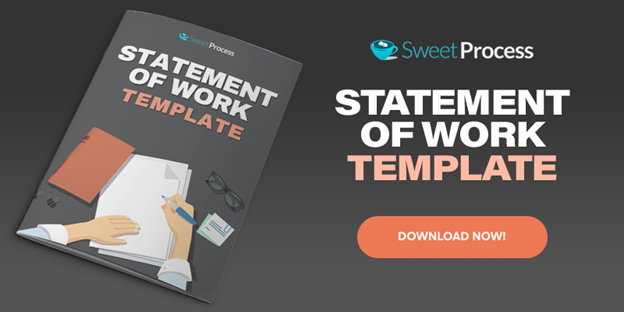


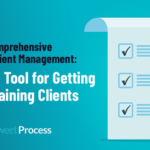





Leave a Reply